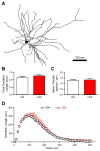Repeated shock stress facilitates basolateral amygdala synaptic plasticity through decreased cAMP-specific phosphodiesterase type IV (PDE4) expression
- PMID: 29204911
- PMCID: PMC5886824
- DOI: 10.1007/s00429-017-1575-z
Repeated shock stress facilitates basolateral amygdala synaptic plasticity through decreased cAMP-specific phosphodiesterase type IV (PDE4) expression
Abstract
Previous studies have shown that exposure to stressful events can enhance fear memory and anxiety-like behavior as well as increase synaptic plasticity in the rat basolateral amygdala (BLA). We have evidence that repeated unpredictable shock stress (USS) elicits a long-lasting increase in anxiety-like behavior in rats, but the cellular mechanisms mediating this response remain unclear. Evidence from recent morphological studies suggests that alterations in the dendritic arbor or spine density of BLA principal neurons may underlie stress-induced anxiety behavior. Recently, we have shown that the induction of long-term potentiation (LTP) in BLA principal neurons is dependent on activation of postsynaptic D1 dopamine receptors and the subsequent activation of the cyclic adenosine 5'-monophosphate (cAMP)-protein kinase A (PKA) signaling cascade. Here, we have used in vitro whole-cell patch-clamp recording from BLA principal neurons to investigate the long-term consequences of USS on their morphological properties and synaptic plasticity. We provided evidence that the enhanced anxiety-like behavior in response to USS was not associated with any significant change in the morphological properties of BLA principal neurons, but was associated with a changed frequency dependence of synaptic plasticity, lowered LTP induction threshold, and reduced expression of phosphodiesterase type 4 enzymes (PDE4s). Furthermore, pharmacological inhibition of PDE4 activity with rolipram mimics the effects of chronic stress on LTP induction threshold and baseline startle. Our results provide the first evidence that stress both enhances anxiety-like behavior and facilitates synaptic plasticity in the amygdala through a common mechanism of PDE4-mediated disinhibition of cAMP-PKA signaling.
Keywords: Basolateral amygdala; Chronic stress; Compartmentalization; Macromolecular complexes; Morphology; a-Kinase anchoring protein.
Figures








References
-
- Abercrombie HC, Schaefer SM, Larson CL, Oakes TR, Lindgren KA, et al. Metabolic rate in the right amygdala predicts negative affect in depressed patients. Neuroreport. 1998;9:3301–3307. - PubMed
-
- Baillie GS, Houslay MD. Arrestin times for compartmentalised cAMP signalling and phosphodiesterase-4 enzymes. Curr Opin Cel Biol. 2005;17(2):129–134. - PubMed
-
- Beylin AV, Shors TJ. Stress enhances excitatory trace eyeblink conditioning and opposes acquisition of inhibitory conditioning. Behav Neurosci. 1998;112:1327–1338. - PubMed
-
- Blair HT, Schafe GE, Bauer EP, Rodrigues SM, LeDoux JE. Synaptic plasticity in the lateral amygdala: a cellular hypothesis of fear conditioning. Learn Mem. 2001;8:229–242. - PubMed
-
- Blitzer RD, Wong T, Nouranifar R, Iyengar R, Landau EM. Postsynaptic cAMP pathway gates early LTP in hippocampal CA1 region. Neuron. 1995;15:1403–1414. - PubMed
MeSH terms
Substances
Grants and funding
LinkOut - more resources
Full Text Sources
Other Literature Sources
Medical

